
Home and security products company Fortune Brands (NYSE: FBIN) missed Wall Street’s revenue expectations in Q3 CY2024, with sales falling 8.4% year on year to $1.16 billion. Its GAAP profit of $1.09 per share was also 3.4% below analysts’ consensus estimates.
Is now the time to buy Fortune Brands? Find out by accessing our full research report, it’s free.
Fortune Brands (FBIN) Q3 CY2024 Highlights:
- Revenue: $1.16 billion vs analyst estimates of $1.24 billion (6.9% miss)
- EPS: $1.09 vs analyst expectations of $1.13 (3.4% miss)
- EBITDA: $259 million vs analyst estimates of $263.7 million (1.8% miss)
- EPS (GAAP) guidance for the full year is $4.20 at the midpoint, beating analyst estimates by 1.4%
- Gross Margin (GAAP): 45.9%, up from 42.8% in the same quarter last year
- Operating Margin: 17.8%, up from 15.6% in the same quarter last year
- EBITDA Margin: 22.4%, up from 21.1% in the same quarter last year
- Free Cash Flow Margin: 15.2%, down from 21.3% in the same quarter last year
- Organic Revenue fell 8% year on year (-3.2% in the same quarter last year)
- Market Capitalization: $10.62 billion
Company Overview
Targeting a wide customer base of residential and commercial customers, Fortune Brands (NYSE: FBIN) makes plumbing, security, and outdoor living products.
Home Construction Materials
Traditionally, home construction materials companies have built economic moats with expertise in specialized areas, brand recognition, and strong relationships with contractors. More recently, advances to address labor availability and job site productivity have spurred innovation that is driving incremental demand. However, these companies are at the whim of residential construction volumes, which tend to be cyclical and can be impacted heavily by economic factors such as interest rates. Additionally, the costs of raw materials can be driven by a myriad of worldwide factors and greatly influence the profitability of home construction materials companies.
Sales Growth
Reviewing a company’s long-term performance can reveal insights into its business quality. Any business can have short-term success, but a top-tier one sustains growth for years. Unfortunately, Fortune Brands’s 3.6% annualized revenue growth over the last five years was sluggish. This shows it failed to expand in any major way, a rough starting point for our analysis.
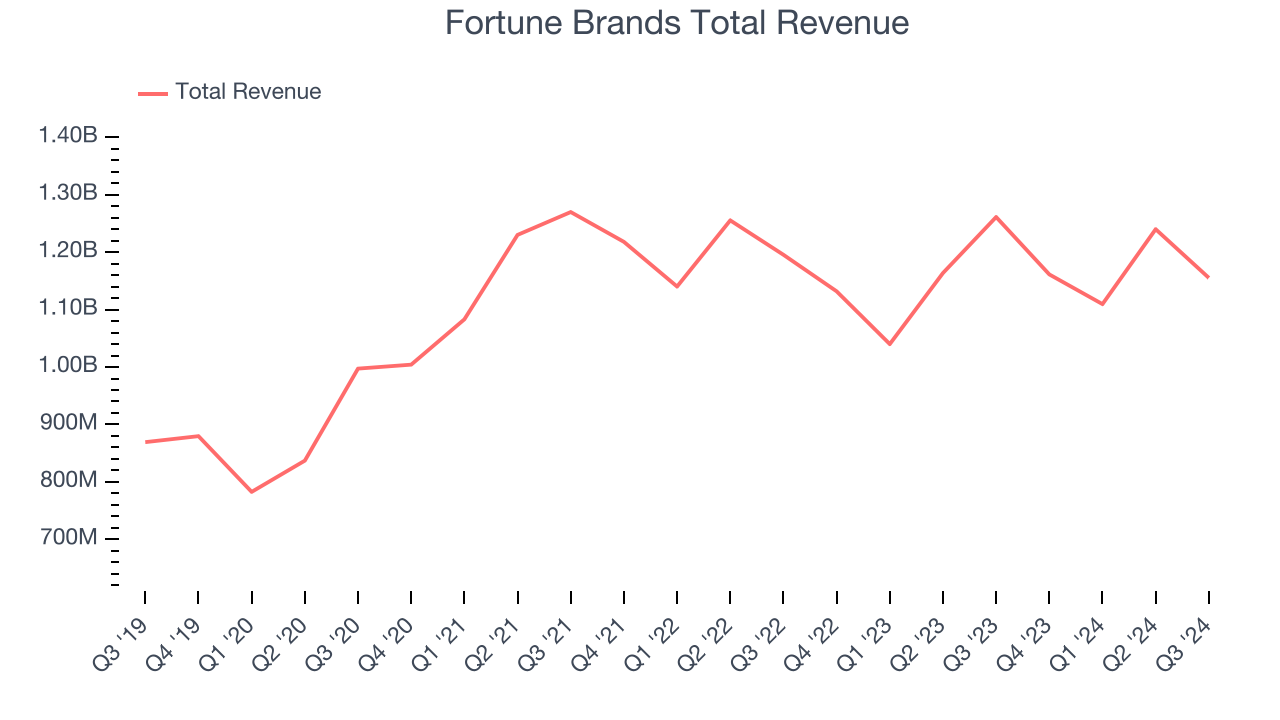
Long-term growth is the most important, but within industrials, a half-decade historical view may miss new industry trends or demand cycles. Fortune Brands’s history shows it grew in the past but relinquished its gains over the last two years, as its revenue fell by 1.5% annually. 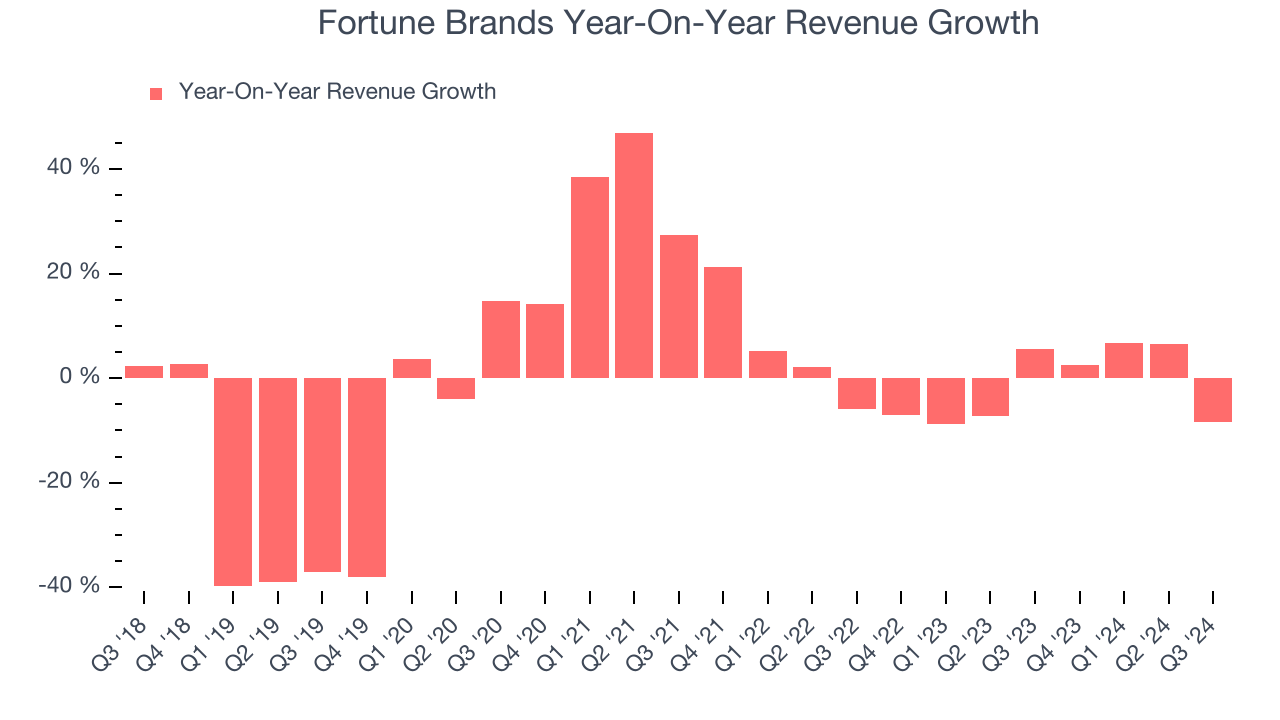
We can dig further into the company’s sales dynamics by analyzing its organic revenue, which strips out one-time events like acquisitions and currency fluctuations because they don’t accurately reflect its fundamentals. Over the last two years, Fortune Brands’s organic revenue averaged 4.8% year-on-year declines. Because this number is lower than its normal revenue growth, we can see that some mixture of acquisitions and foreign exchange rates boosted its headline performance. 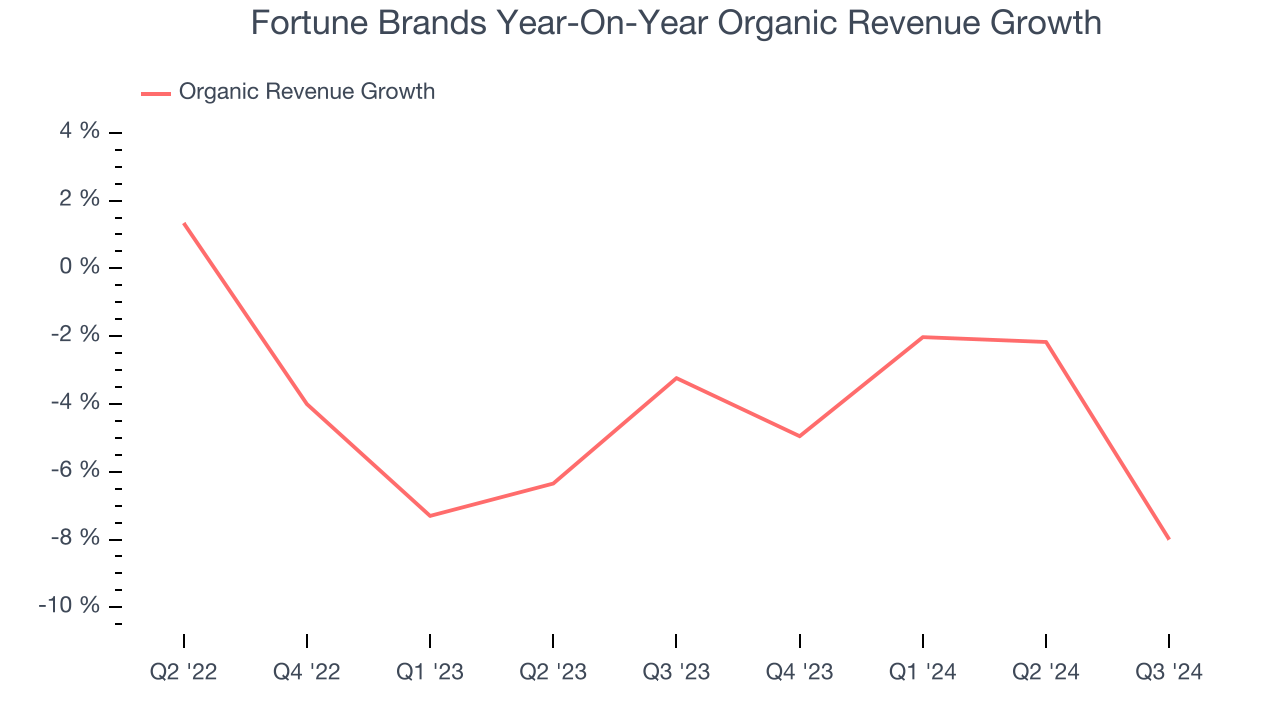
This quarter, Fortune Brands missed Wall Street’s estimates and reported a rather uninspiring 8.4% year-on-year revenue decline, generating $1.16 billion of revenue.
Looking ahead, sell-side analysts expect revenue to grow 5.8% over the next 12 months, an improvement versus the last two years. Although this projection indicates the market thinks its newer products and services will spur better performance, it is still below average for the sector.
Unless you’ve been living under a rock, it should be obvious by now that generative AI is going to have a huge impact on how large corporations do business. While Nvidia and AMD are trading close to all-time highs, we prefer a lesser-known (but still profitable) semiconductor stock benefitting from the rise of AI. Click here to access our free report on our favorite semiconductor growth story.
Operating Margin
Operating margin is a key measure of profitability. Think of it as net income–the bottom line–excluding the impact of taxes and interest on debt, which are less connected to business fundamentals.
Fortune Brands has been a well-oiled machine over the last five years. It demonstrated elite profitability for an industrials business, boasting an average operating margin of 17.9%. This result was particularly impressive because of its low gross margin, which is mostly a factor of what it sells and takes huge shifts to move meaningfully. Companies have more control over their operating margins, and it’s a show of well-managed operations if they’re high when gross margins are low.
Analyzing the trend in its profitability, Fortune Brands’s annual operating margin decreased by 6.9 percentage points over the last five years. Even though its margin is still high, shareholders will want to see Fortune Brands become more profitable in the future.
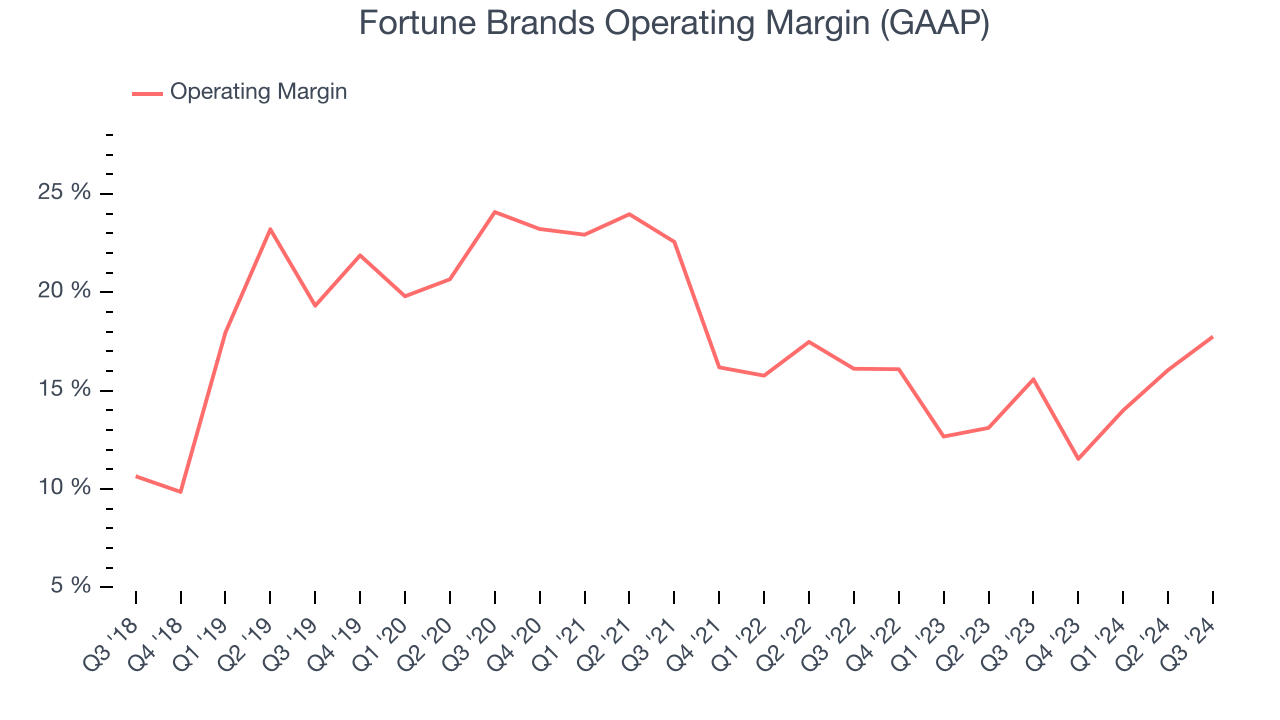
This quarter, Fortune Brands generated an operating profit margin of 17.8%, up 2.2 percentage points year on year. Since its gross margin expanded more than its operating margin, we can infer that leverage on its cost of sales was the primary driver behind the recently higher efficiency.
Earnings Per Share
Analyzing revenue trends tells us about a company’s historical growth, but the long-term change in its earnings per share (EPS) points to the profitability of that growth – for example, a company could inflate its sales through excessive spending on advertising and promotions.
Fortune Brands’s unimpressive 4% annual EPS growth over the last five years aligns with its revenue performance. This tells us it maintained its per-share profitability as it expanded.
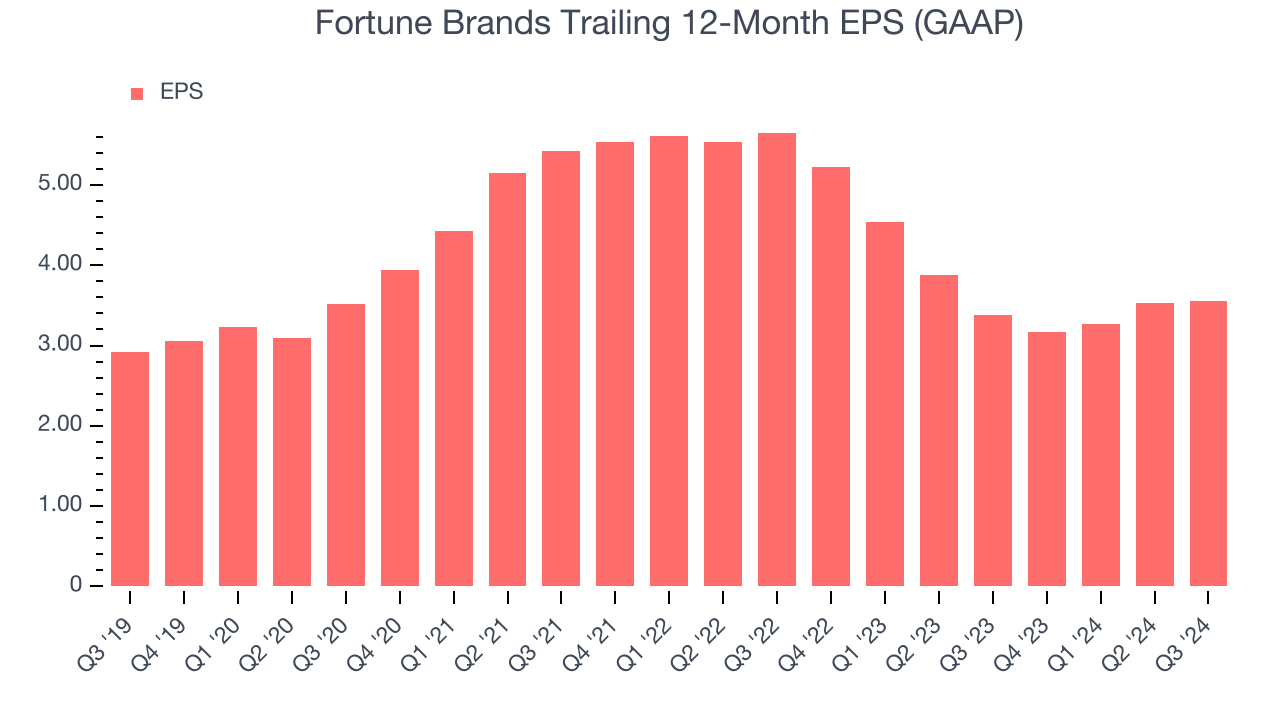
Like with revenue, we analyze EPS over a more recent period because it can give insight into an emerging theme or development for the business.
For Fortune Brands, its two-year annual EPS declines of 20.7% show it’s continued to underperform. These results were bad no matter how you slice the data.In Q3, Fortune Brands reported EPS at $1.09, up from $1.07 in the same quarter last year. Despite growing year on year, this print missed analysts’ estimates. Over the next 12 months, Wall Street expects Fortune Brands’s full-year EPS of $3.55 to grow by 31.7%.
Key Takeaways from Fortune Brands’s Q3 Results
We enjoyed seeing Fortune Brands beat analysts’ full-year EPS guidance expectations. On the other hand, its revenue missed and its organic revenue fell short of Wall Street’s estimates. Overall, this was a weaker quarter. The stock traded down 4.5% to $80.49 immediately after reporting.
Fortune Brands may have had a tough quarter, but does that actually create an opportunity to invest right now? When making that decision, it’s important to consider its valuation, business qualities, as well as what has happened in the latest quarter. We cover that in our actionable full research report which you can read here, it’s free.


















